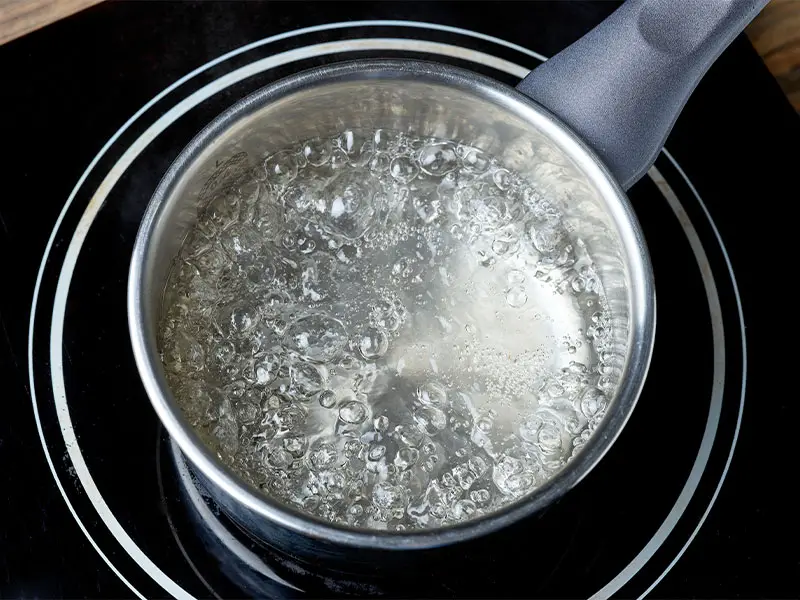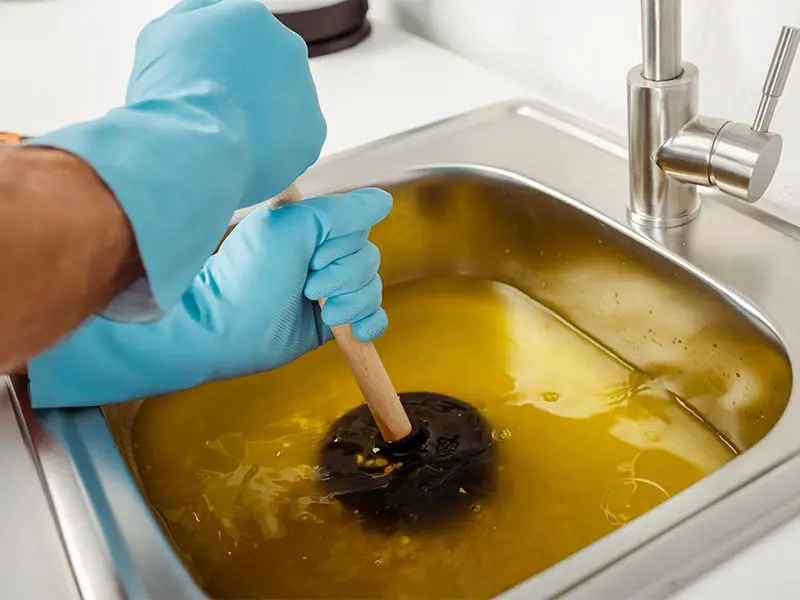If your kitchen sink drain is clogged, then most probably due to the deposition of leftover food wastes and grits inside the drain.
Different food substances are more responsible for causing a clogged drain. Such as fats, oils, grease, and starch.
These food components easily create build-up inside the drain and further cause the drain to clog gradually.
Among them, the most common culprit is grease. And the issue with grease is that you might avoid throwing all other food components, but it’s tough to prevent grease.
And not only hard to avoid but also hard to identify it to be the main culprit behind a clogged drain.
Therefore, to make it easier for you, in this article, I’ll be discussing how to unclog a grease-clogged drain and whether Drano is effective in removing such drain clogs.
Quick Answer
To remove the grease inside the drain, the easiest and safest way is to use boiling water which can melt down the fat. If it doesn’t work, you can try vinegar and warm water solution, a plunger, a Carbon Dioxide Drain Gun and Hydro Sewer Jet.
How Does Grease Form?
Grease is a very stubborn and regular component. It exists in more or less all types of food except fruits and vegetables.
It includes meat, dairy products, coffee, eggshells, and other essential daily food components. Again, fruits or vegetables combined with oil also form grease.
But foods aren’t only responsible for grease. One of the most significant contributions to building grease inside the kitchen sink drain is played by dishwashing soaps and detergents.
Since most of the soaps are made of animal fat, the fat is converted into grease when it remains stuck to the drain pipe walls for a long time.
Grease is such a thing that even if you clean your drain hole every day, it will build up anonymously.
And for this reason, grease is generally considered the most common culprit in causing a drain clog.
Many times, in the lower portion of the pipe, where the warm water gets cooler before reaching, the fats and oils stuck to the walls become solid, reacting with the cold water and air inside the pipe.
This further causes the grease to float on the water surface of drainage. Then, gradually, these greases cover up the top of the pipe as well.
Over time, more fatty, oily, and greasy substances tend to arrive and accumulate at the bottom of the pipe forming a massive substantial blockage caused by grease.
How to Unclog a Grease-Clogged Drain?
There are several methods to unclog a grease-clogged drain. How you should opt depends on how complex the grease-built clog is.
Let’s look at some of the easiest and safest hacks and methods you should try first to unclog your grease-clogged drain.
Boiling Water
This is the simplest yet very effective hack to remove a grease clog. All you need to do is boil some water in batches and pour them down the drain one after another.

And then, check whether the clog is removed and whether the water still overflows when you open the faucet.
If it doesn’t, your grease clog is successfully removed. But if it does, that means the clog is still there, so keep on continuing the process.
But you should try this only if your drain pipes are metal, not plastic. Or else, the boiling water might damage, lighten, or melt down your drain pipes.
Vinegar and Warm Water Solution
If just boiling water doesn’t seem to work to unclog your grease-clogged drain, then try a solution of vinegar and warm water.
For this, you can use any white vinegar available in your kitchen. All you need to do is add vinegar and warm water in a 50:50 ratio in a bowl and then mix them well.
And then, drop the solution down the drain. After dropping the solution, pour some boiling water to wash the clog away. If your pipe is made of plastic, avoid this step.
This time, the grease clog should be removed. If you still don’t observe a satisfying result, repeat this process until the results are delightful.
Plunger
A plunger is a handy plumbing tool. Using a plunger to remove the grease clog can be a temporary solution if you have one in your house.
You must cover the drain hole entirely with a plunger and then plunge it fiercely several times.
The plunger uses a strong air force to dissociate and break down the clog into small pieces. But it can’t be a long-term solution.

Because it won’t remove or eliminate the grease from the drain. All it will do is break down the clog. And so, there’s a high chance of the grease building up once again sooner.
Thus, if plunging seems to break down the grease clog, you can follow it with a batch of boiling water or vinegar solution to clean away the grease residues.
Carbon Dioxide Drain Gun
If you have tried all three of the above solutions properly, but none worked to remove the grease clog in your drain, it indicates it is too solid and stubborn.
Therefore, in this case, you can use a potent plumbing tool called the carbon dioxide drain gun or any other tool with compressed air.
You can find it in any of the local plumbing stores in your area if you don’t have one already in your house.
As the grease clogs inside your drain are very stubborn, it requires force to break them down. This tool uses compressed air to push down and break even the most challenging clogs down a drain.
Hydro Sewer Jet
This should be the last thing you can try to unclog your stubborn grease-clogged drain if all the other methods above don’t seem to work.
But it is not recommended for you to use a hydro sewer jet if you haven’t used it before and are not skilled.
Will Drano Unclog Grease?
Different forms of Drano are made for different purposes, so the Drano Kitchen Granules Clog Remover is specially made for quickly melting grease clogs from the kitchen sink drain.
The Drano Kitchen Granules form a significant amount of heat when poured through the drain hole, which melts them down immediately when it reaches the grease blockage at the bottom of the pipe.
But not to mention, using Drano is quite risky, especially when it’s as strong as melting down a stubborn grease clog.
It can damage your nose and lungs if its fumes are inhaled and can damage your skin or eyes if it comes into contact. For more details about the harmful effects of Drano fumes, refer to the article “Is It Bad to Breathe in Drano?”
That is why Drano should be the last option to unclog a grease-clogged drain.
Final Words
I hope I was able to help you solve your nightmare of a grease-clogged drain. And if still your problem isn’t solved, then consulting a professional plumber is the only option left for you.
But before that, you must try all the above methods carefully and adequately with perseverance to get the expected result.
Thanks for reading till the end!

James is an organic fertilizer professional who owns a successful organic fertilizer company in new jersey. He is an expert in waste management in both houses and community cases. In his free time, he loves to write about his experiences in the field.


5 thoughts on “How to Unclog a Grease Clogged Drain”
Comments are closed.